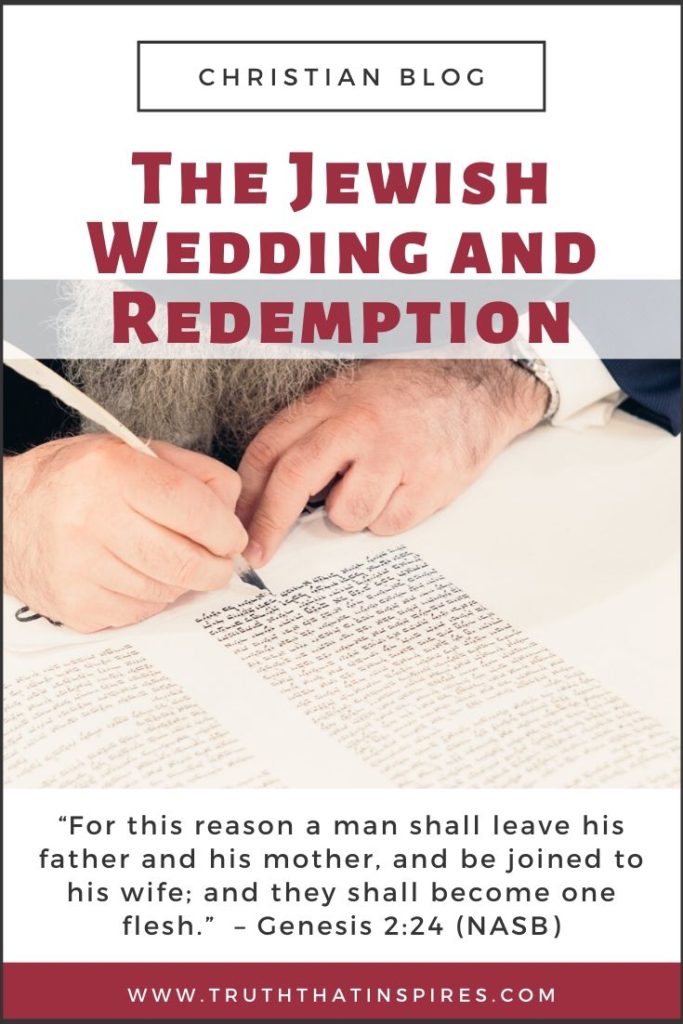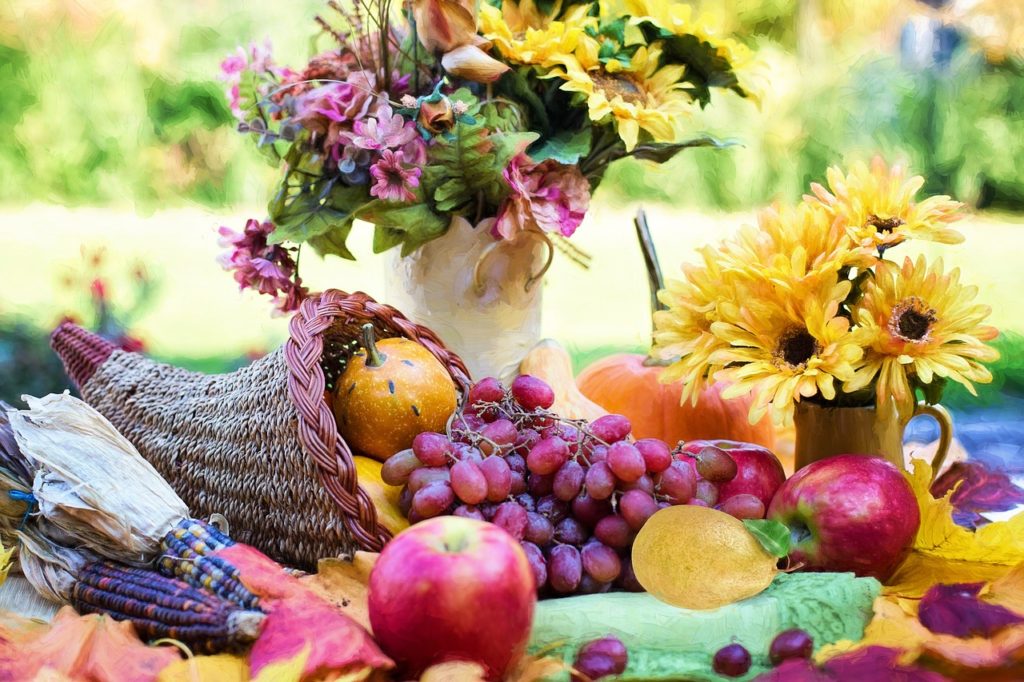Marriage between man and woman is a covenant established by God in the Garden of Eden (Genesis 2:24). The Bible refers to the body of believers as the bride (Jeremiah 2:1-2; 2 Corinthians 11:2-3) and Jesus as the groom (Isaiah 54:5; Hosea 2:16). The similarities between covenant marriage and God’s redemption plan for mankind are striking. The following is a comparison of the Jewish wedding’s seven steps and God’s plan of salvation.
Save this Pin for later!

1. The Arrangement & Contract
Jewish Wedding: In ancient Israel, weddings were arranged by the parents. The father of the groom would choose the bride he believed would be the best companion for his son. He would then negotiate a suitable dowry (Hebrew: mohar) with the future bride’s father (Exodus 22:16-17; Deuteronomy 22:28-29). Once a contract (Hebrew: Ketubah) outlining conditions of betrothal and roles of the husband and wife was signed and the dowry paid, the two were legally married to each other. The bride would be considered consecrated or set apart exclusively for her bridegroom. The groom would announce to the village, “the price has been paid in full” or “it is finished” to signify the marriage covenant was complete. As a symbol of covenant relationship, the bride and groom would drink from a cup of wine over which a betrothal benediction was pronounced. From this day the bride would wear a veil indicating her betrothal to the groom.
Plan of Salvation: Father God has chosen the bride for His son Jesus (John 15:16). The price, or mohar, was the blood of Jesus Christ (Luke 22:20; John 3:16; Acts 20:28) which purchased and redeemed the church from the father of this world, Satan (John 8:44). The written contract is our Bible which spells out the roles and responsibilities of the Church. The groom has announced that the contract is paid in full and that it is finished (John 19:30). The symbol of the covenant is the cup of communion (Luke 22:20; 1 Corinthians 11:25). The betrothal is called the kiddushin (from Kadosh – holy) meaning “sanctification.” The church is covered by the Holy Spirit, the veil of the covenant.
2. The Preparation of the Bride Chamber
Jewish Wedding: After the marriage contract is ratified the groom would announce that he is going to build the canopy (Hebrew: chuppah), an addition onto his father’s house which would become their first home as husband and wife. After his announcement, the bride would inquire when he would return. The groom would reply, “I do not know, only the father knows the day” (Mark 13:32-37). Only when the father inspected and approved the chuppah would he allow his son to return to get his bride. It would take a minimum of a year to build the addition. This time would also serve to prove the virginity of the bride.
Plan of Salvation: Jesus left earth to be with the Father to prepare the future abode in heaven for believers. The church is now living in this stage of the wedding. Only the Father knows the time of His Son’s return (John 14:1-3).

3. The Purification of the Bride
Jewish Wedding: While the groom is building the chuppah, the bride is going through a sanctification or purification process. During this time, the bride would be baptized in a mikvah, a pool called a Mayim Chaim (with inflow and outflow). This ceremonial act represented a spiritual cleansing, a newly transformed way of life from a single woman to a bride-to-be. She would be trained by the village women in the proper role of a good wife. It was also a time to prove her purity to the groom for if she became pregnant during this time the covenant would be annulled. As mentioned in step 1, she would wear a veil and headband with coins signifying that she was a betrothed woman sealed for marriage (Ephesians 1:13). It was during this time in Joseph and Mary’s marriage that Mary became impregnated by the Holy Spirit.
Plan of Salvation: The church is now undergoing a sanctification or purification process to be “set apart” for the Messiah. As the church becomes transformed by the Word of God (Romans 12:2) and takes on the mindset of Christ she becomes more and more that “holy virgin” to be presented to Him (Ephesians 5:26-27).
Ezekiel 16:8-9; 1 Corinthians 1:2, 6:11; 2 Corinthians 11:1-2; Ephesians 5:29; Hebrews 10:10, 13:12
4. The Fetching of the Bride
Jewish Wedding: When the father of the groom inspects and approves the bridal chamber he will allow his son to go get his bride. This usually occurred at midnight and was a surprise to all of the bride’s party. The scene is described in Matthew 25:1-13. The groom and best man, along with his entourage, leave the father’s house in a procession (Hb: nissuin) to fetch the bride. As they got closer to the bride’s house, the best man would run ahead and shout the pending arrival (Matthew 25:6; John 3:29) and blow the shofar signifying they have arrived (1 Thessalonians 4:16). The bride would put on her kittel (white garment) and meet her groom to return to his father’s house for the ceremony.
Plan of Salvation: John the Baptist called himself the friend of the bridegroom and fulfilled the traditional role of announcing the groom to his bride (John 3:29). The fetching of the bride corresponds to the rapture of the church explained in 1 Thessalonians 4:13-18. It will occur at the “twinkling of an eye” for only the Father knows the return of His Son (Luke 12:40; 1 Corinthians 15:50-58).
5. The Wedding Ceremony
Jewish Wedding: The actual marriage ceremony is conducted in the house of the groom’s father. A few invited guests (immediate family and two witnesses) would attend. The ceremony completes the wedding covenant making it legal and binding.
Plan of Salvation: There will be a wedding ceremony in heaven between Jesus Christ and His eternal bride, the church. Those who have gone before, saints of old, will attend with believers who have been raptured (1 Thessalonians 4:17; Revelation 19:6-8).
Three Points to recognize at this point in the wedding:
- The marriage of the Lamb has come: The heavenly ceremony is consummating.
- The wife has made herself ready: She is now glorified. There is no spot, wrinkle, blemish nor any such thing.
- The bride is in fine linen (kittel), bright and pure: The fine linen represents the righteousness of the saints. The sanctification process has ended, and the virgin is now presented to the Messiah at the wedding ceremony.
6. Consummation of the Bride & Groom
Jewish Wedding: After the wedding ceremony the bride and groom go into the bridal chamber and consummate the marriage. The groomsmen and bridesmaids would wait outside during this time called the huppah. After the consummation, the groom would reveal evidence of his bride’s purity and virginity to his best man.
Plan of Salvation: The place Jesus is preparing for His bride is the New Jerusalem where believers will join Him for eternity. Jesus and His bride will experience spiritual union after their arrival in heaven, thus consummating their covenant marriage. Only those written in the Lamb’s Book of Life (invitation book) will enter into eternal bliss (Matthew 19:6; Revelation 19:9-21).

7. The Marriage Feast
Jewish Wedding: After the consummation, a week of celebration begins called the wedding feast (Hebrew: seudah). More people are invited to the wedding feast than the wedding ceremony. During the feast, the bride is kept in the bridal chamber until the last day when she is revealed to everyone (Colossians 3:4; Jude 14).
Plan of Salvation: Whereas saints of old and the raptured attended the wedding ceremony, saints after the tribulation and thousand-year reign will join in the festive wedding feasts. The completed Kingdom of God begins at the wedding feast and continues forever (Revelation 19:9).
This topic was presented at the Coastal Community Church 1st Annual Marriage Retreat. A printable pdf version of this information can be viewed and/or downloaded from our Resources page. Other topics presented at the retreat include The 5 W’s and H of Marital Conflict and God is Not Who You Think He Is.
Have you signed up for our email list? If you give us your email address, we’ll make sure you never miss a post and are kept up to date on all the latest resources that we offer (average of only one to two emails/week). You can also choose to read through the Bible in one year with us. We'll send you the reading assignment each week with a snippet highlight (average of one email/week). We promise that we will not sell your information and you can be removed from the list at any time by clicking the unsubscribe link at the bottom of each of our emails. See our Privacy Policy for more details.
Below are the latest offers from our Affiliate Partners. Please click the links and visit their sites.
They have lots of products at great prices. We may make a small commission if you purchase through these links which help keep this website up and running and the best part is... there is no extra cost to you! Read our Disclosure for more information. For more details on each affiliate see our "Shop" page.
